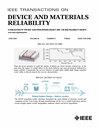SOI FinFET Design Optimization for Radiation Hardening and Performance Enhancement
IF 2.3
3区 工程技术
Q2 ENGINEERING, ELECTRICAL & ELECTRONIC
IEEE Transactions on Device and Materials Reliability
Pub Date : 2023-06-20
DOI:10.1109/TDMR.2023.3287839
引用次数: 1
Abstract
This work proposes Total Ionizing Dose (TID) hardening techniques compatible with conventional 14-nm-node silicon-on-insulator (SOI) FinFETs’ process flows through performing 3-dimensional (3-D) simulations based on technology computer-aided design (TCAD) tools. The simulation results reveal a significantly critical TID impact induced by trapped charges in the buried oxide (BOX) and the spacer with calibration against 14 nm SOI FinFET’s experimental data (error ¡ 6%). Inspired by the physical interpretation, an optimization technique featuring an optimized gate structure, spacer length, and substrate bias is designed. The optimized gate structure is utilized to enhance the local gate-to-channel coupling at the bottom and reduce the generation and capture of electron-hole pairs. By reducing the spacer length, a lower sensitive volume in the spacer can effectively suppress the TID response. The setting of the negative substrate bias greatly improves the subthreshold characteristics, weakening the TID effect in the BOX. By adopting the combined optimization including these techniques, the threshold voltage shiftSOI FinFET辐射强化与性能提升设计优化
这项工作提出了总电离剂量(TID)硬化技术,该技术通过基于计算机辅助设计(TCAD)工具的技术进行三维(3-D)模拟,与传统的14纳米节点绝缘体上硅(SOI) finfet的工艺流程兼容。根据14 nm SOI FinFET的实验数据(误差为6%),模拟结果表明,埋地氧化物(BOX)和间隔层中的捕获电荷对TID有显著的临界影响。受物理解释的启发,设计了一种优化栅极结构、间隔长度和衬底偏压的优化技术。优化后的栅极结构增强了底部局部栅极-通道耦合,减少了电子-空穴对的产生和捕获。通过减小隔离剂长度,隔离剂中较低的敏感体积可以有效地抑制TID响应。负基板偏置的设置大大改善了亚阈值特性,减弱了BOX中的TID效应。采用上述技术组合优化后,5 Mrad(SiO2)辐照诱导的阈值电压位移$(\Delta V_{\ mathm {TH}})$可降至21 mV,而仅优化栅极结构的阈值电压位移$\Delta V_{\ mathm {TH}}$为45 mV,未硬化的阈值电压位移$为97 mV。同时,辐射后的$I_{\mathrm{ON}}/ $I_{\mathrm{OFF}}$增加到$1\乘以10\,\,^{\mathrm{7}}$,比原器件至少提高了4个数量级。同时,亚阈值摆幅(SS)从81 mV/dec降至71 mV/dec,漏极诱导势垒降低(DIBL)从120 mV/V降至99 mV/V。该组合优化设计是在不影响性能的情况下提高对TID辐照耐受性的有效方法,可促进14nm SOI FinFET在未来恶劣空间环境中的应用。
本文章由计算机程序翻译,如有差异,请以英文原文为准。
求助全文
约1分钟内获得全文
求助全文
来源期刊

IEEE Transactions on Device and Materials Reliability
工程技术-工程:电子与电气
CiteScore
4.80
自引率
5.00%
发文量
71
审稿时长
6-12 weeks
期刊介绍:
The scope of the publication includes, but is not limited to Reliability of: Devices, Materials, Processes, Interfaces, Integrated Microsystems (including MEMS & Sensors), Transistors, Technology (CMOS, BiCMOS, etc.), Integrated Circuits (IC, SSI, MSI, LSI, ULSI, ELSI, etc.), Thin Film Transistor Applications. The measurement and understanding of the reliability of such entities at each phase, from the concept stage through research and development and into manufacturing scale-up, provides the overall database on the reliability of the devices, materials, processes, package and other necessities for the successful introduction of a product to market. This reliability database is the foundation for a quality product, which meets customer expectation. A product so developed has high reliability. High quality will be achieved because product weaknesses will have been found (root cause analysis) and designed out of the final product. This process of ever increasing reliability and quality will result in a superior product. In the end, reliability and quality are not one thing; but in a sense everything, which can be or has to be done to guarantee that the product successfully performs in the field under customer conditions. Our goal is to capture these advances. An additional objective is to focus cross fertilized communication in the state of the art of reliability of electronic materials and devices and provide fundamental understanding of basic phenomena that affect reliability. In addition, the publication is a forum for interdisciplinary studies on reliability. An overall goal is to provide leading edge/state of the art information, which is critically relevant to the creation of reliable products.
 求助内容:
求助内容: 应助结果提醒方式:
应助结果提醒方式:


